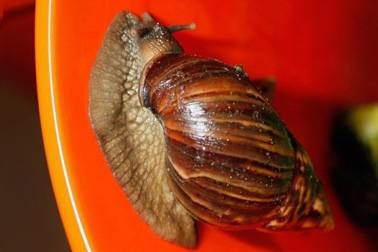
Miami is being invaded again, and we''re not talking about snowbirds — though this problem moves just as slowly. More than 33,000 giant African land snails have been captured since the invasive species began taking over parts of the city and suburbs in September, officials say, and the fight continues on.
One of the largest snails in the world, the giant African land snail (or GALS, as the state calls them) can reach up to 8 inches in length and nearly 5 inches in diameter. GALS can live up to nine years, boast both male and female reproductive organs, and reproduce rapidly, each snail laying about 1,200 eggs per year. The nocturnal creepers are also a menace to more than 500 crops, eat the stucco off of houses, and known to carry a parasite charmingly called ''rat lungworm''.
As if that resume wasn''t strong enough, GALS can also carry a strain of meningitis that can be transfered to humans.
"It''s us against the snails," said Richard Gaskalla, director of plant industry at the Florida Department of Agriculture. His department has undertaken a massive eradication program after an original infestation was first spotted near Coral Gables, then spread rapidly to northwest and southwest Miami, Hialeah, Kendall Hammocks, and beyond. According to an October survey map, the sluggish invaders had made it as far as 18 miles from the first sighting.
With up to 200 state and federal departments of agriculture employees on the front lines at a time, the good guys are making headway. But they''ve seen it before, and they''re digging in for a fight: according to the Associated Press, the only successful eradication program to date happened after a boy brought three giant African land snails to Miami from Hawaii in 1965. It took 9 years to collect 17,000 snails, costing the state $1 million.
With 33,000 captured in just four months, the 2011 war is clearly a much bigger problem — but exactly how much bigger is still hard to tell.
"We''ve been holding at 13 core areas in Miami-Dade County for a number of weeks without a new discovery," Florida Department of Agriculture spokesperson Denise Fiber told HuffPost Miami. "Right now we''re estimating what our resource needs are for about one year out. It''s all kind of unknown at this point."
Making the depth of the problem more difficult to determine, Fine said, is that investigators collecting from a property only see about 5 percent of the snails that are there. She said investigators are also using bait, which the snails will eat and will eventually kill them, but the process is painstaking.
Giant African land snails are illegal to import, and officials still trying to pinpoint the source of the current infestation. Fine said the USDA is investigating links to Santeria, and according to the Miami Herald there is speculation it is related to a smuggling case last year in which a woman claiming to be an African priestess hid snails in her clothes on flights to Miami. She was allegedly aiding a Hialeah practioner of Ifa Orisha, who urged his followers to drink the juice from the snails in a healing ritual, leaving several of them violently ill.
Most of 33,000 horror movie-sized snails have been captured thanks to the public reporting sightings to a special snail hotline (a very adorable wanted poster doesn''t hurt, either). Authorities urge anyone who spots GALS to refrain from touching them and instead call help line at 888-397-1517. Workers then ID and collect the snails before taking them off to be killed in a freezer, in what Gaskalla told NPR is a "kindler, gentler way to get rid of them."
Courtesy of: http://www.huffingtonpost.com

